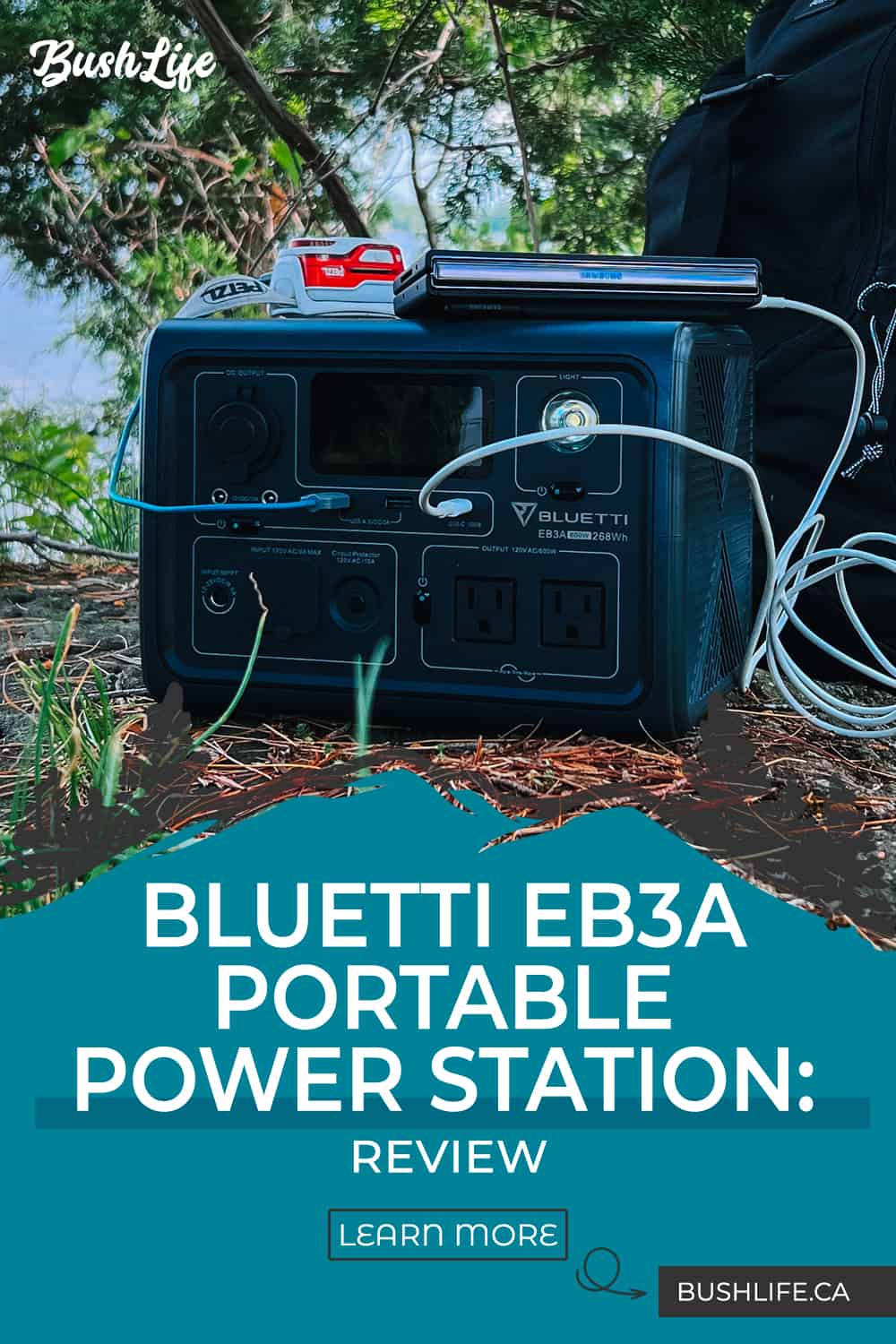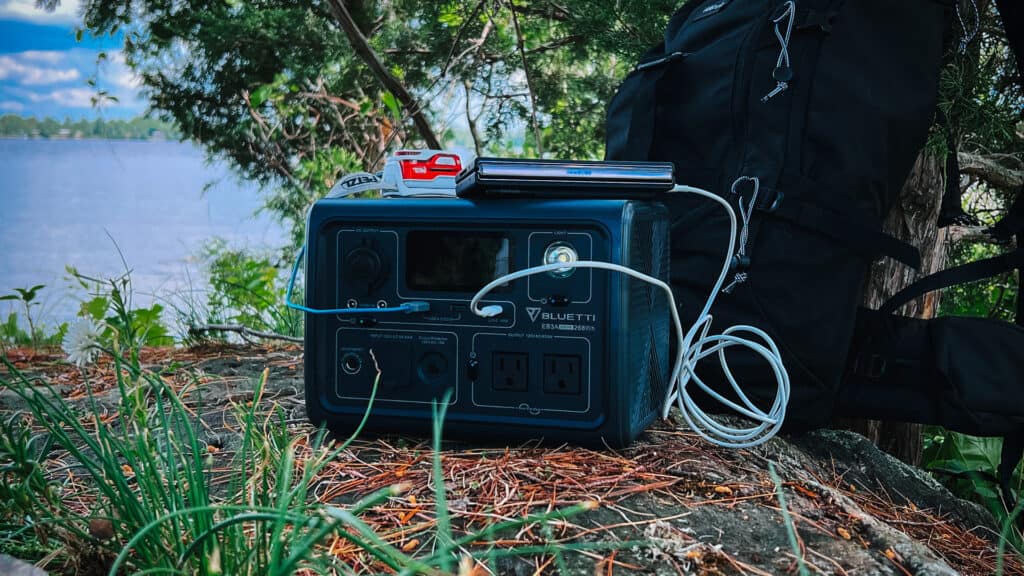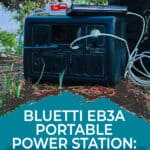Yes, you can have electricity ANYWHERE you go! If that’s not enough, you can do it all within a tiny package. That’s thanks to the Bluetti EB3A, a game changer for camping, off-grid living, hunt camps, multi-day fishing trips, etc. It even applies to the digital road warrior, photographer, RC enthusiast or anyone who carries battery-operated devices.
What we all have in common is more and more power-hungry devices like our phones, laptops, GPS, cameras and so on. Devices that would only last until the charge dissipates when you’re in the backcountry – Until now!
In this post, we will review the Bluetti EB3A portable power station. We will address its function and merits and look at how to incorporate portable power into your next adventure! So let’s get started!
Discloure: Posts may contain affiliate links. Purchases made through our links result in a small commission to us at no charge to you. We only recommend products that meet our brand standards based on testing and first hand use by our authors.
Bluetti EB3A Portable Power Station
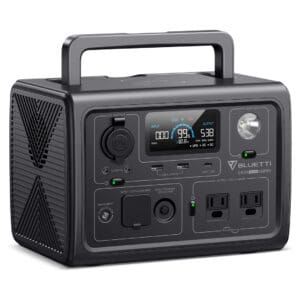
A small and mighty, battery based (268 Wh lithium iron phoshate) portable power station. Using USB A&C, cigarette lighter socket and inverter based AC output (2 outlets). Solar, DC car charger and household AC charging inputs. It’s an amazing little unit and our first 5 star review!
Pros
Small package with lots of power
Super fast charging
Smart interface
Long life battery
Great price
Cons
Won't shut off when plugged in
What is a Portable Power Station?
We already know that to use electricity, we need to tap into it (power lines) or make it ourselves, which classically means a gas generator. Now, you are hauling a heavy generator and gasoline, and you need to deal with fumes and noise – all while also keeping it out of the rain. And that can be a challenge if not a royal PITA. Imagine tent camping with neighbours in a provincial or state park – you know that’s not happening based on noise alone.
Solar generation is always an option to “make” electricity. But it can be slow, not always readily available, and needs to be built up or “stored” (through batteries) to have an actual purpose for future use.
But wait, battery technology has come a very long way, so much so that we can have a lot of energy stored in a battery that is small and light enough to carry around. That covers the portability side of things – and that solar panel we just talked about is infinitely more helpful. It allows us to tap into a resource when away from civilization.
In order to be a power station, it should be able to use a remarkable battery to provide for our electrical needs. So, how about an all-in-one unit with a battery and DC power outputs to charge things via USB and your classic cigarette lighter socket? Add to this station an inverter to get AC power for all your corded 120v needs. You now have a power station!
What Can You Run (or Charge) with the Bluetti EB3A?
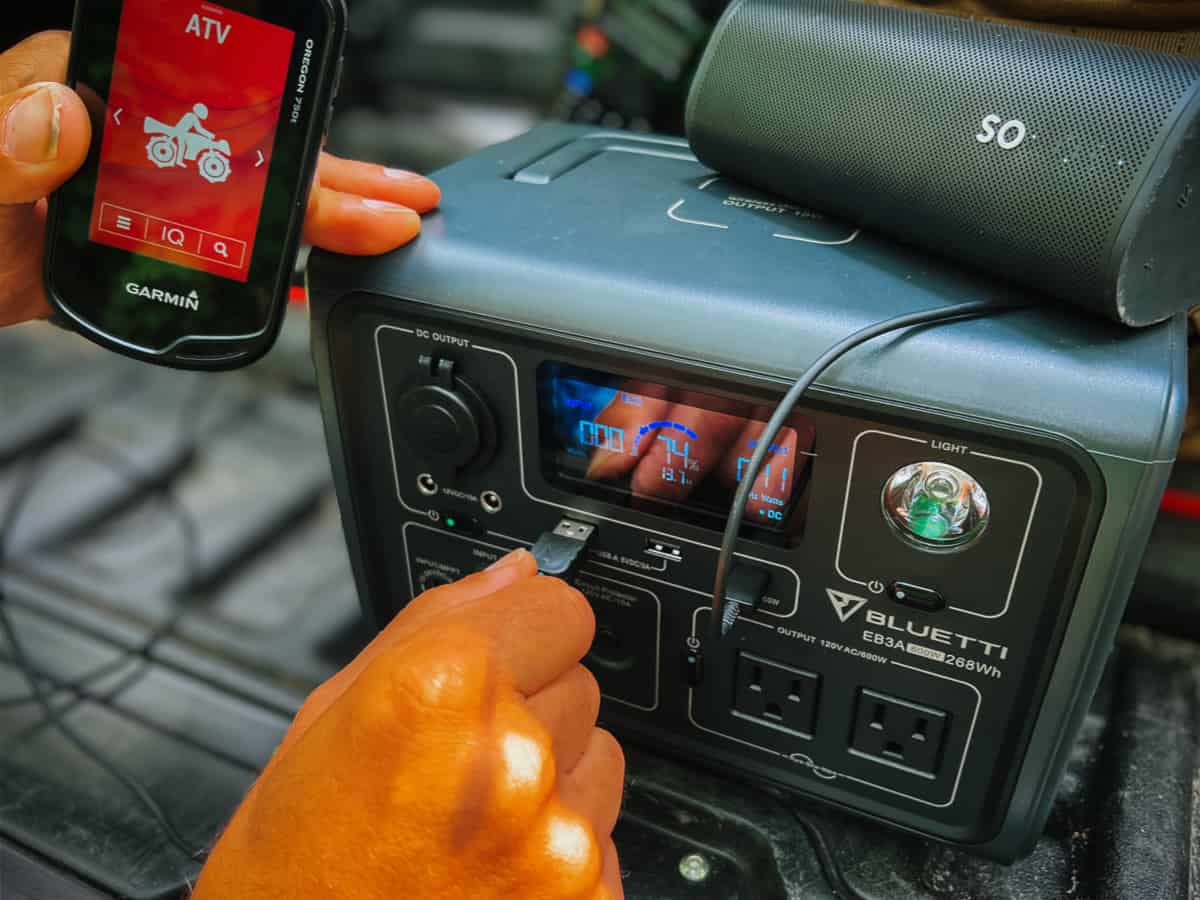
USB-A
Bluetti provides 2 USB-A ports. These ports are rated at 5 volts and 3 amps each, which is nice, as it’s a fast charge rate for a classic USB port.
I have a 2020 Jeep with built-in USB ports, and I swear it can’t be more than an amp as it charges painfully slow. The other day, I drove for 4 hours, and it didn’t finish charging my iPhone, which was already at 50%. 3 amps is outstanding!
USB-C
Here, we get 1 USB-C port. If you don’t know the difference between USB-A and C, the easiest way to tell is by the plugs’ size. USB-C is a lot smaller. It’s also a LOT faster!!! Many phones, tablets, and even laptops use USB C to charge, which is fantastic as you don’t need to haul around those awful big bricks with the thick AC cables they used to come with. I’m on a Lenovo Thinkpad right now that charges with USB-C.
Here’s the kicker – I also have an Apple MacBook bought in the last few years that also charges via USB C. The Apple brick is rated at 61 watts, while the Bluetti EB3A goes up to 100 watts! That’s plenty of power that can charge a multitude of devices – for years to come.
Wireless Charging
Forgot your phone cable? No problem! On the top of the EB3A, the unit has a handle and some non-descript writing indicating wireless charging. I tested my iPhone 11 on it, and it works like a charm. It’s rated up to 15 watts, well past my phone’s charging capability of 7.5 watts. Again, as the tech catches up to the EB3A, we will be ready for even faster charge rates.
Other DC Ports
In the DC section of the Bluetti power station, you’ll also find an old-school 12-volt cigarette lighter socket. The socket is rated for up to 10 amps. And yes, it’s still very useful as it powers many devices, such as air mattress pumps.
There are also 2 x DC5521 ports. These are barrel connectors and another way of connecting DC devices, such as certain 12-volt appliances. You may or may never use this, but it’s there in case you ever need it, and I guarantee Bluetti isn’t going to drive up the cost of these units by adding uncommon connectors.
120 V AC Power
The EB3A has a built-in inverter with 2 AC outlets. The inverter is rated for 600 watts and up to 5 amp devices. Below is a table of a few standard devices that you may be able to run with the Bluetti Portable Power Station EB3A:
| Device | Running Watts |
|---|---|
| Fridge/Freezer | 700 |
| Lights | 600 |
| LED/LCD TV | 120 |
| Desktop Computer | 400 |
| Laptop Computer | 75 |
| Hand Drill | 600 |
| Slow Cooker | 250 |
These ratings aren’t etched in stone. They are general guidelines for typical devices. I pulled these figures from Generac, a large generator manufacturer specializing in automatic backup power for residential and commercial properties. Ie. I trust their numbers.
If your device does not indicate watts, don’t panic! Most devices have some consumption info on the back from which you can calculate watts. The formula is simple: Watts = Volts x Amps. In other words, anything you plug in will be 120 volts. Let’s take the drill for an example – 5 amps x 120 volts will equal 600 watts.
Off-topic: for North America, the Bluetti EB3A can also output 220V, but the amperage drops to 2.6 amps. So yes, you can very well sit in a café in Paris, smoke your cigarettes to a fancy espresso, and you won’t miss the soccer game because you CAN plug in a European 220-volt TV! There’s just something cool about that thought.
Surge Power
Here’s an interesting topic for electricity. Take a drill, for example. When you initially pull the trigger, it takes a lot more effort (meaning energy) to get it spinning than it does to keep it running. So, a device rated for 5 amps might momentarily surge to 7.5 at startup, then drop and run continuously at 5 amps. This can pose a serious problem as that surge can knock out a breaker which protects its power source and/or knock out the power source altogether forcing a shutdown.
It should be noted that the EB3A power station is rated up to 1200 watts surge capacity. What this means is the EB3A can temporarily handle up to 1200 watts and continuously run 600 watts. But with the caveat that the extra surge capacity is not for all devices, which we’ll cover a bit further below.
Pure Sine Wave Inverter
Here’s a second interesting topic for electricity. There is such a thing as clean electricity and dirty electricity. It also has nothing to do with the environment or HOW electricity was made in this context.
Old school gas generators, for example, are big, loud, heavy and not of the “cleaner” variety. Some newer gas generators incorporate inverters to offset these problems and output a cleaner power source. But the price goes up substantially for an inverter-based generator, and not all inverters are created equally!
The EB3A uses a pure sine wave inverter – this will ensure the AC output is “clean” and suitable for sensitive electronics such as computers. By clean, we are referring to the frequency of the power. You have all seen references to such things as 60 hz and sine waves. So, to not bring back memories of high school science class, let’s move on with this little equation: clean power = safe for a laptop!
Actual AC Run Time
For some real-world statistics of the Bluetti EB3A review, I plugged my 65″ Sony smart TV into the Bluetti EB3A power station. The EB3A ingeniously displays battery capacity, output wattage and estimated runtime based on the current load. Upon turning everything on with the power station fully charged, it measured the TV at 160 watts and estimated runtime of 1.5 hours.
I plugged the TV in at 10:30 am, and it died at 11:57 am. The estimation was accurate to within a few minutes. That’s impressive! I’m also happy with an hour and a half off such a small device. You have to remember that it’s a unit small enough that I can hold it up in the palm of my hand!
Charging Your Phone
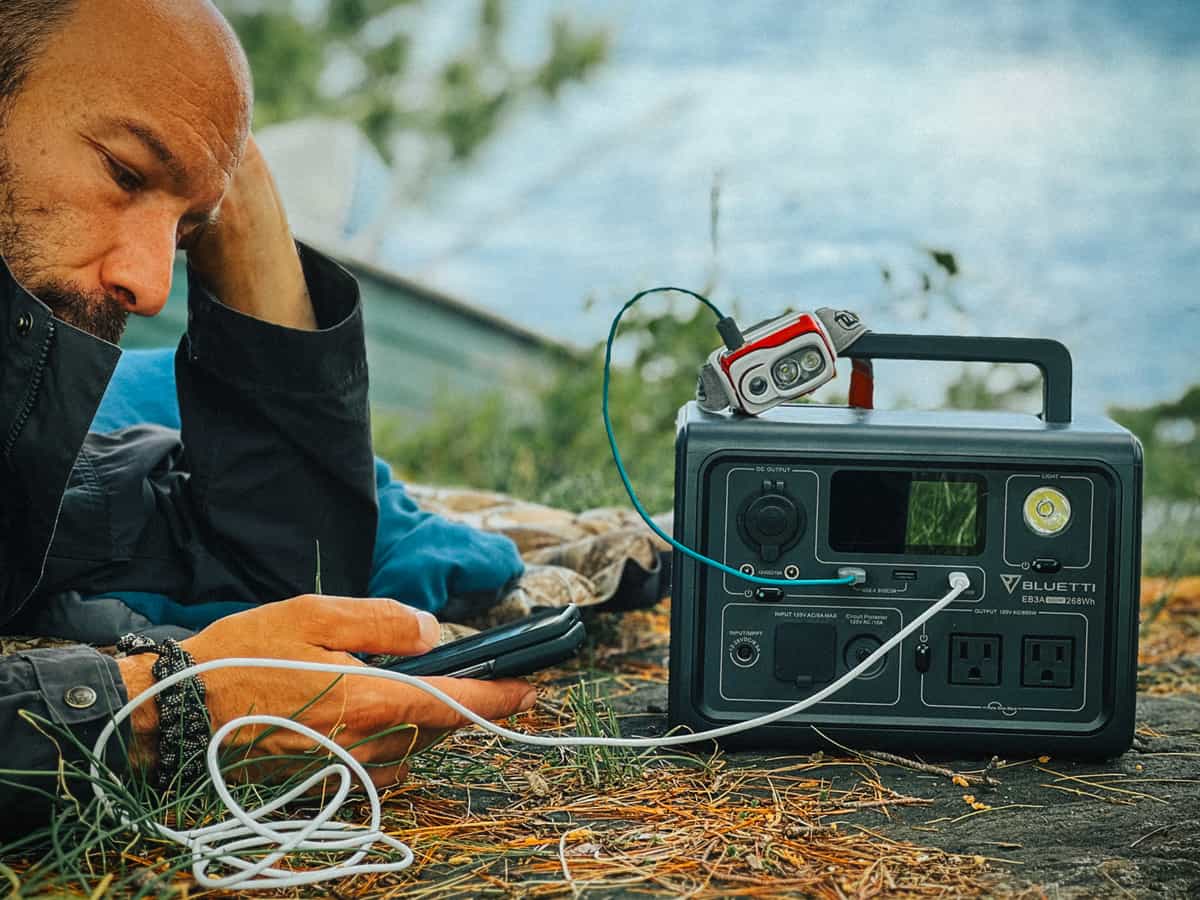
Yes, I know, it’s probably the one thing you are dying to know. Bluetti claims it charges an iPhone 12 25 times. So I took my iPhone 11 at 29% and plugged it into the EB3A, which was at 100%. After fully charging the phone, the EB3A dropped to 93%, or so it lost 7% of its power. And since 100 divided by 7 = 14.3, that’s the number I’m going with:) It may not be 25x, but honestly, I’m happy with that. I can’t stress enough that the EB3A is a small unit.
Charging the Bluetti EB3A
Now that we know what we can run with the EB3A, and let’s face it, that’s the juicy part, let’s look at what it takes to recharge the unit. And I have to tell you, this is where the EB3A shines. I mean really, really shines!
AC Charging
The EB3A arrived at my house late Friday afternoon. I didn’t think much of it other than unboxing and plugging it in so I could test it out the next day. It arrived partially charged to 60%. Ok, no big deal, let’s plug it in. I didn’t time it, but about 25 minutes later, I walked by only to notice it was at 100%. What? Really? That’s insane, and I like it a lot!
Now I’m curious as to how long a full charge takes. So after draining it completely (with the big screen TV), it recharged in 1 hour and 33 minutes to 100%. Bluetti claims on their website that the unit charges to 80% from empty in just 30 minutes – and that’s completely believable as those numbers assume a dual charge rate of AC and solar for a total rate of charge at 430 watts.
When I plugged in on AC alone, the initial charge rate was 265 watts and 50 minutes later, the rate slowed down to 104 watts. That makes sense: as batteries fill up, the charge rate lowers. With AC charging alone, the EB3A achieved an extremely impressive milestone of being charged to 79% in 50 minutes, which is impressive!
Many companies are getting into these portable power stations, such as Jackery, Ecoflow, Anker, Goal Zero and so on. While I can’t speak to those as I don’t own any, based on what other reviewers have to say, they charge substantially slower. For example, a comparable Jackery unit (sub $300 US) took 5 hours to charge. Very quickly, it becomes obvious that it’s one of the EB3A’s best features.
Solar Charging
The EB3A has a separate solar charging input. It also came with cables incorporating the appropriate MC4 connectors. The panels can be connected in series or parallel, but they must be within the following specs: 12-28 volts, 8.5 amps max, and input power up to 200 watts max.
Solar charging is a camper or off-gridder dream! The blazing-fast charge rate of the EB3A makes it the ideal companion for the off-gridder as it allows a recharge on those days when the sun isn’t out for long. Going back to the Jackery, there are plenty of days when we don’t get 5 hours of sun – and if you have my luck, it’s usually raining when you are camping:)
Bluetti solar panels are purchased separately, which makes sense as not everyone needs them.
Other Charging Methods
This power station can also charge via a cigarette lighter socket (cable not included) or a generator.
Once you have a second charging source, you can get into combination charging modes such as AC + Solar. Or even AC + T200S (AC to DC adapter), but let’s call that AC+AC since we are technically using a secondary AC source to provide a DC power input.

Practical Applications
I stayed at a friend’s hunt camp last December, and every day after the hunt, we’d get a fire going in the tiny cabin for heat, and we would start the little Honda generator for power. The Hondas are great little machines, but we ran a 2200-watt generator for 5 hours a day only to run a super tiny TV, DVD player, one light bulb and one phone charger. ALL things the EB3A can handle easily, without the fumes and buzzing.
When watching TV at night and getting tired, you would have to go out and shut off the generator. Come back with a flashlight, often in the rain and always in the cold, and you would wake up while doing so. Now, I’m not complaining, as it’s part of the off-grid experiences. However, this can be avoided with a good power station and solar panels.
Failing a sunny day or not having solar panels, we still have a huge upside, thanks to the EB3A’s remarkable recharge rate. We could run that same generator for an hour to recharge the power station, AND that means we only need 1/5th of the gas we would typically use! Gas that needs to get to the middle of nowhere, which takes more room in the truck, space that could be used for other gear.
Pass Through Charging
Pass-through charging means we can use the EB3A’s output power while simultaneously charging the unit itself. In other words, the EB3A doubles as a UPS or uninterrupted power supply. The UPS is an old concept for computers so that when the power goes out, you can finish and save your work – and shut your machine down gracefully.
Take the example we have above with my friend’s hunt camp, and let’s couple that with the EB3A’s pass-through charging capability. We couple plug in the TV, DVD player, lightbulb, cell phone charger and so on into the power station. We then run power from the solar panels and/or generator to the Bluetti EB3A’s charging input. And off-grid life just got a lot easier! There’s no need to EVER change cabling.
Unless it has a pass-through charging feature, I would wholeheartedly recommend that you NOT buy one! And that’s for a multitude of reasons.
Lithium Iron Phosphate Battery! And Why That Matters
Naturally, we can’t skip over the actual heart of this power station, and that is its battery.
Going back to when I was a kid with an RC car in the 80s, rechargeable batteries were something new. Dare I say it, it was space age and mythical at the time. But they were NiCd (nickel-cadmium) and had quite the memory effect – meaning you had to be anal about fully draining them and fully charging them to maintain their capacity. Next came NiMh (nickel metal hydride), which was better, but not perfect.
Now, we are in the lithium days, and lithium-ion has been around for a while. And as far as I know, they have no memory effect. For RC cars now, where we need sudden and quick power, Li-Po batteries are a big rage. But these guys can blow up when charging. While probably rare, the risk is there. That’s not the case with the EB3A, see below.
EB3A Battery Specifications
The Bluetti EB3A incorporates a newer lithium ion-based technology – LiFeP04 or lithium iron phosphate. Quoting Wikipedia, these batteries are “lower cost, high safety, low toxicity, long cycle life”, meaning it has everything a consumer is looking for, and if you haven’t guessed, these are popular for EVs and backup power.
Now comes the part of why we are talking about batteries so much. According to Bluetti, the EB3A is rated for 2500+ life cycles to 80%. This means you can charge it thousands of times before its battery can only use 80% of its original power. That is insane, and here’s some math: even if you fully drain and charge it daily (2500 / 365), it will last for 6.8 years, at which time it will still give you 80% capacity.
These numbers are not just marketing hype either. It’s common knowledge. At 2500+ life cycles for LiFePO4, the numbers are quite conservative. Comparatively, in a solar generator aspect, traditional lead acid (car batteries) are rated for 200-300 life cycles and anywhere from 500-2500 for lithium-ion. There are portable power stations from big brands rated for only 500 life cycles – and if you’re not buying a Bluetti with a LiFePO4 battery, I suggest you do your homework BEFORE BUYING!
Size
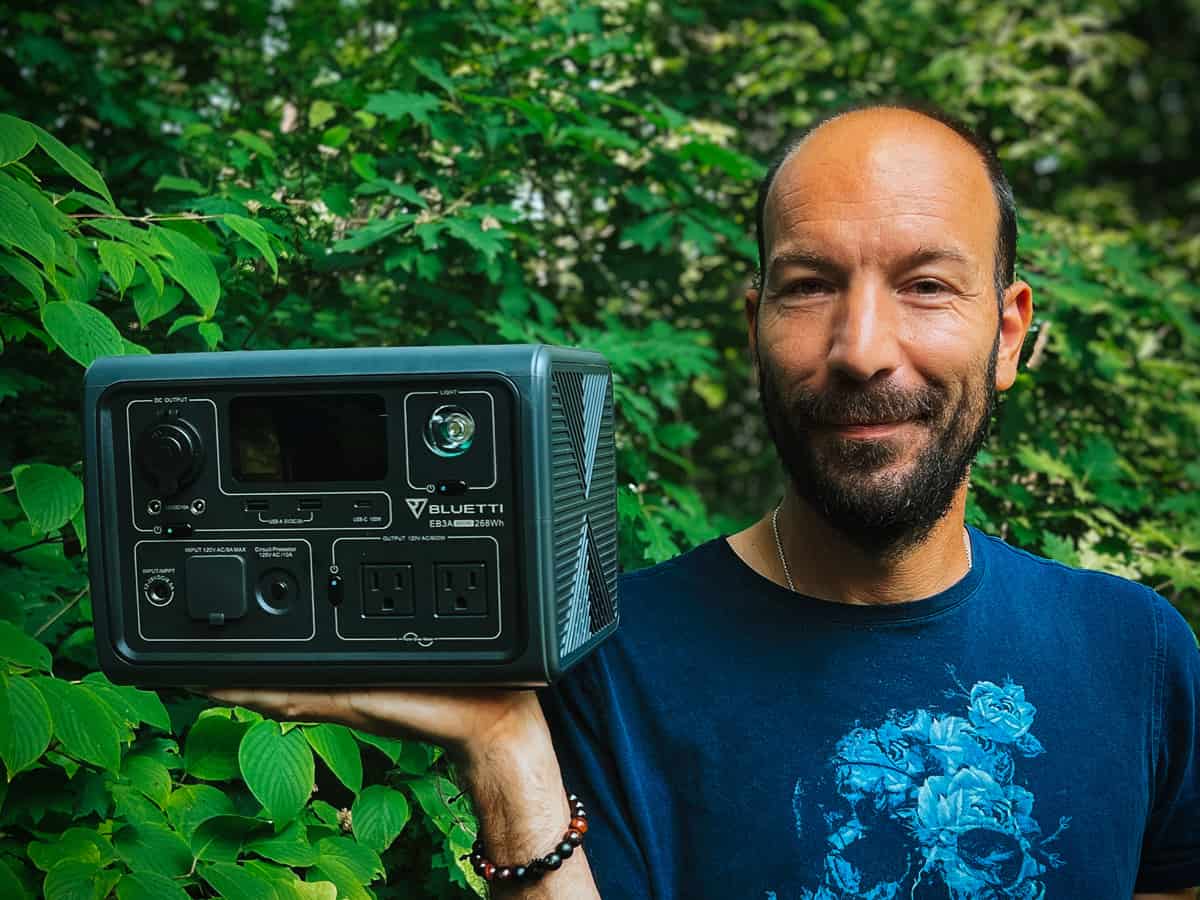
The EB3A is Bluetti’s smallest power station. It comes in at 10.04″ long x 7.09″ wide x 7.2″ tall. It’s also 10.14 pounds, but it feels like half its weight thanks to its top folding grab handle.
But product reviews are a funny thing. Any reviewer can regurgitate the specs and give you their opinion. A better reviewer will put products through its paces, which we always do here at BushLife. But the most important thing I always stress is to consider YOUR intended use! Otherwise, none of this matters!
A Larger Power Source
So, let’s put the EB3A into perspective based on size vs power and compare it to a larger unit:
| Old School: Honda Eu200i Generator | Modern: Bluetti AC200P |
|---|---|
| 1800 watts continuous | 16.5″ x 11″ x 15.2″ LxWxH |
| 20.0″ x 11.4″ x 16.7″ LxWxH | 60.6 pounds |
| 46.5 pounds dry! | no gas! |
| Plus gas… | no noise! |
While you have about triple the power in either unit, you also have at least double the bulk and 6x the weight, regardless of the unit. Don’t get me wrong, as both are great units. I’m not knocking them at all. My point is, that you don’t want to lug these around for day trips, weekends, etc. You want to carry as little as you need to get by, which is what I mean by intended use.
Finding a Balance
The ideal portable power station is the one that will give you all the power you need. But it will do so in the lightest and smallest package possible! Just be sure to factor in recharge capabilities, and you might just be able to get away with a lot less than you think.
From experience on my hunting trips or camping adventures, I simply don’t have room for anything larger than the EB3A. With the ability to charge an iPhone 13-17 times or a laptop 5-6 times, it also does exactly what I need.
Other Cool Features
You thought we were finished, didn’t you? Almost, but not yet. Of course, the EB3A has an app, so let’s talk about it amongst some other things.
The Bluetti Phone App
A quick download on the iPhone app store and down comes the Bluetti app. Even without an account in its “offline” mode, the app detects the EB3A through Bluetooth. One click brings up this screen here:

The top row shows charging inputs. Left is solar (DC), right is grid (AC). Since it’s plugged in, it lights up green, with watts at 0 since the unit is at full charge. In the middle, large numbers show the battery’s charge capacity in percent. Below are the outputs. DC on the left shows it’s on and outputting 6 watts (charging an iPad on USB-C) and AC on the right.
At the bottom is a red button to turn the unit off (including Bluetooth). The DC and AC tabs separately control their respective output functions with the ability to turn them off and on.
It’s easy to access, nice and simple, and very responsive! I love the app so far.
Settings Panel
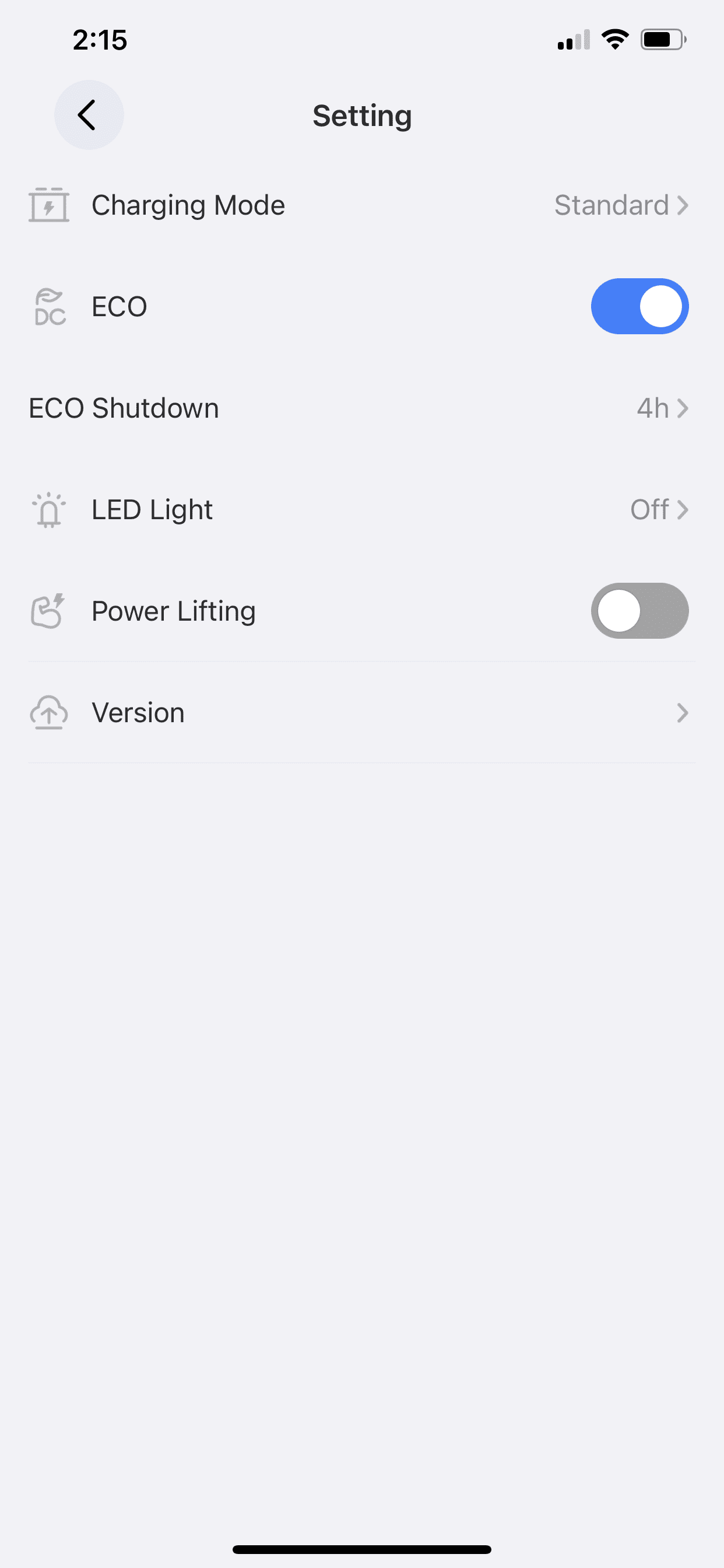
Charging mode does something cool. It provides 3 options: standard, silent, and turbo. I recommend using the default setting of the standard, as faster charger rates aren’t always good for batteries. But it’s there if you need it – with some added fan noise. Silent charges silently (no cooling fan noise) but at the expense of speed.
ECO is an auto power-off function. LED Light turns on the EB3A’s built-in light.
Powerlifting doubles the AC wattage to 1200 (remember that surge capacity we talked about), but ONLY for certain heating devices like space heaters or electric irons. NOT applicable for motors.
Finally, the version covers firmware and updates.
The settings pane is straightforward, and most people will not need to fiddle with it. If I had a complaint, the LED light should be on the main screen as it’s more of a function than a setting. So it should be easier to get to. Finally, the app is also available for Android.
Built-In Light
Generally, I find built-in lights to be hokey. It’s the type of thing you find on $25 cigarette lighter socket air compressors. I have to say, the EB3A’s light is very bright and helpful. It’s also only a button press away on the front panel of the unit. It also toggles between medium, high and SOS. The SOS is a strobe. I’m pleasantly surprised here, and with LED, it should last as long as the unit itself.
Cons
Nothing is ever perfect, is it? However, sometimes things are genuinely negative, and for other items, we just want features that are important to us but may not be for others. The EB3A has a few, albeit very minor flaws.
Parasitic Draw
When plugged in on AC power (but fully charged to 100% for quite some time) the unit does get warm. That means it’s drawing energy, and we know it’s happening since it’s converting that energy to heat. This is called a parasitic draw, and it’s needless.
It’s been very hot outside at the time of writing – I mean 30 degrees Celsius, and I just flipped over to air conditioning mode. With no AC, it’s been 26-29 degrees indoors, so the EB3A’s fan even comes on from time to time during this idle period of not charging.
As an update, the weather has cooled, and this fan noise has disappeared. It’s typical room temp at around 22.5 degrees, so that’s good news.
Now, if you go to the Bluetti app to turn the unit off, it simply instructs you to unplug from AC power first. In other words, as long as it’s plugged in, you can’t shut it off. I see this as a genuine negative since being plugged in guarantees it’s drawing some power. But then again, MOST devices we own are always plugged in and have a parasitic draw… Even the microwave is constantly sniffing for a software update:)
Speaking of software, I suppose it’s an issue that can be solved with a future firmware update. And yes, it is 100% capable of updating its firmware or “brains.”
Buttons / Screen Timer
Pressing any button on the unit awakens its beautiful info panel that shows the charge level, power going in, and power going out. But that times out after so many seconds. I wish there were some settings in the app to control the delay before it shuts off the display. Perhaps even always leaving it on when plugged into the AC.
As to buttons, you have to hold them to toggle on or off their actual functions. Whether that is DC or AC output, I wish the toggle was a button press, as it takes a little getting used to.
These are minor issues and more of a pet peeve.
The Verdict
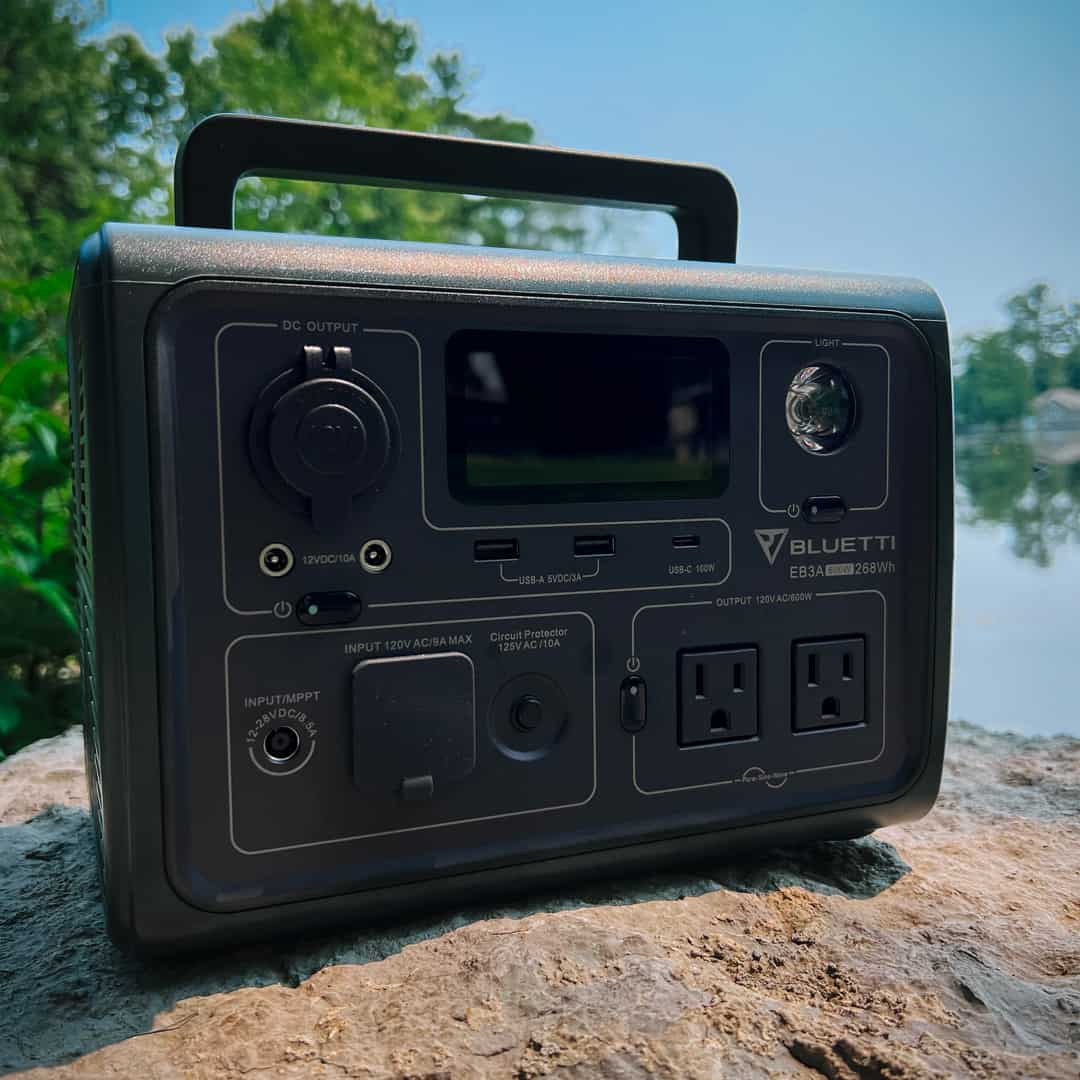
Let’s see, I always carry a phone. As an outdoorsman, I carry a headlamp and flashlight. As a father, I worry about survival, so now add a GPS – and the kids’ iPads… And don’t get me started as a blogger. As content creators, we NEED a DSLR camera, GoPro, Insta360, drone, portable accent lighting and, of course, a laptop. I’m happy to report the EB3A charges them all easily and on the go! I also couldn’t be happier owning one of these units.
If you are into the outdoors or getaways, or maybe your life is about being on the road, a portable power station is a must! And the Bluetti EB3A is a sure winner, especially with how quickly it re-charges and is “back in action.” I could NOT be happier!
I hope this guide was helpful! If you need more ideas, feel free to share your thoughts in the comments below or connect with us on social media to share your suggestions and join the conversation!
Disclosure
Bluetti provided the EB3A for us to review. They did not provide payment for this post nor are we sponsored by Bluetti. The review is based on our unbiased opinion and real world testing of the product. Links to Bluetti and other products on our site do provide a small commission to BushLife at no cost to you. We appreciate you using our links and sharing on social media – it greatly helps the blog and allows us to keep great content coming to you.
Bookmark this post on Pinterest for future reference!
